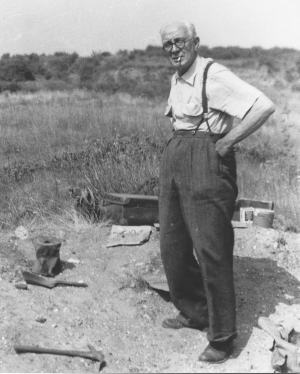Interpretation
The Swanscombe Skull

The Swanscombe Skull, right side view [Photo: NHM]
On Saturday 29 June 1935 Alvan T Marston, a dentist with an interest in the Palaeolithic, was searching the quarried faces in Barnfield Pit for flint tools.
In one face, six feet above the pit floor, he spotted what he thought might be a bit of bone sticking out.
On closer inspection he, as a dentist, immediately recognised it as a human occipital bone (ie. from the base of the skull at the back).
Despite the possibility of subsequent controversy over its position, he realised he couldn't leave it where it was, so marked the spot, left the bone in the keeping of the local chemist, left a note begging the foreman not to dig the site away before more detailed examination and sent an urgent telegram to the British Museum.
Nine months later, on Sunday 15 March 1936, having spent most of his weekends searching near the same spot and harbouring some bitterness and frustration over the lack of official support for further investigation, Marston found another part of the same skull, the left parietal.
Amazingly, a third separate part of the same skull was found just under 20 years later on Saturday 30 July 1955, during investigations by John Wymer at a spot more than 80 feet from the earlier discoveries.

Alvan T. Marston at Barnfield Pit, Swanscombe, 31 July 1955 (From the Wymer Collection)

Alvan T. Marston at Barnfield Pit, Swanscombe, 31 July 1955 (From the Wymer Collection)

Speculative hunting scene at Swanscombe [Photo: NHM]
Although the skull is often colloquially called "Swanscombe Man", the delicate muscle attachments suggest it was in fact a young woman, despite its thickness. The inside of the skull reveals the shape and size of the brain, which are similar to those of modern humans.
However, the proportions of the skull and a small depression near its base are features shared with the much later Neanderthals; it appears that Swanscombe Woman was both a descendant of Boxgrove Man, and a distant ancestor of the Neanderthals. She came from one of the higher gravel horizons, rich in pointed handaxes.
How she died we do not know. Illness, disease or childbirth are all possibilities; or perhaps she had too close an encounter with one of the lions or bears that roamed the landscape, fighting over the carcass of a deer.